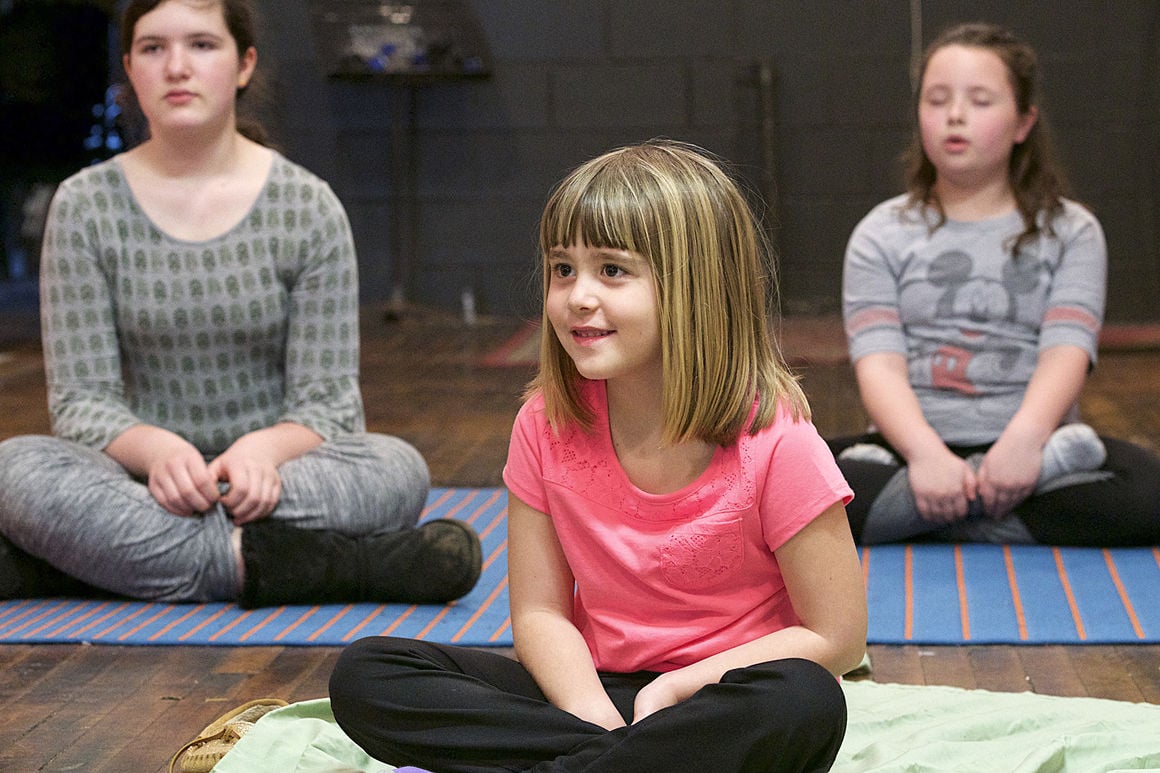
Randi Pierce, age 6, of Clifton (in the foreground) and Gwen Jones, 11, of Kankakee, and 9-year-old Maya Machev, of Watseka, took part of the Kids Meditation Workshop, led by Skylar Brinkman at the Feed Arts & Cultural Center Sunday afternoon in Kankakee. The workshop taught kids mindfulness tricks they could use when feeling stressed, concerned about a school project or even to help fall asleep. Mindfulness can also help improve classroom behavior; that means better grades and less disciplinary actions.
Is meditation the future of detention? Well, it is a possibility.
"I watched a video about an inner-city school that tried meditation with their primary grade students instead of implementing the usual detention, and I was really interested in the concept," said Skylar Brinkman, intern at Feed Arts and Cultural Center in Kankakee.
Meditation is known to promote mindfulness, which leads to a host of other positive behaviors. The video inspired Brinkman to propose meditation workshops specifically targeted to children and adolescents. This past Sunday, she hosted two separate workshops, one for children through the age of 12, and the other for adolescents 13 through 18 at Feed.
The video that Brinkman saw was published on Upworthy.com. It also was mentioned in a recent article in Forbes by Alice G. Walton, who reported on the benefits of meditation for young people in a high-risk school district in California. After a period of half-hour meditation sessions, the students showed better attendance and grades, fewer suspensions and happier and less aggressive behavior.
"Meditation has many benefits for kids, and one of the benefits is that it teaches impulse control," said Lia Schillinger, of Kankakee, who brought her 5-year-old daughter, Madelyn Schillinger-Hogan, to the Feed workshop.
How did Brinkman get 5- to 11-year-old kids to focus on meditating? As a former dance student, she also incorporated dance into the workshop.
Her song of choice? Taylor Swift's "Shake it Up." This activity allowed the little attendees to exert themselves enough to feel their heartbeat. Finding and focusing on the heartbeat would be a recurring theme throughout the workshop. "If they can't find anything else to focus on, they can always find their heartbeat," Brinkman said.
Then Brinkman had each attendee blow through a straw and move a piece of cotton along a line of masking tape attached to the floor. She varied the activity a few times before moving into the next portion of the workshop.
Brinkman asked the attendees to do what she called a 5, 4, 3, 2, 1 exercise. She asked the group to look around the room and find five things they could see, four things they could hear, three things they could feel, two things they could smell and one thing they could taste. She added that this exercise could be used in school or anytime they found themselves losing concentration or focus.
Then she got to the guided meditation. Brinkman had the kids lie on their backs and imagine themselves as hard spaghetti noodles. She used the analogy of inserting the stiff spaghetti noodles into warm water. She then went through a sequence in which she asked them to relax each part of the body from the toes to the top of the head. Brinkman said they could use this activity any time they were feeling stressed or concerned about a school project or assignment or even when they got into bed at night to help them to fall asleep.
Then Brinkman had the attendees color a geometric design using crayons or pieces of multicolored tissue paper. She told them that they could use this picture as a focusing point from now on. "The act of coloring itself is also a calming and focusing activity," she said.
As for future classes, Brinkman is eager to try meditation classes again, although no definite dates have been set.
What did the attendees take from the workshop? Maya Machev, a fourth-grader from Watseka, said, "It was fun; I really liked how creative our instructor was."
Likewise, Lily Walker-Dionne, a third-grader from Aroma Park, said, "I liked it, and I had fun."
http://www.daily-journal.com/life/is-meditation-the-future-of-detention-for-school-kids/article_c0c103ac-0999-5146-8ece-34039531af88.html
Daily Journal/David Volden - Lori Krecioch - Mar 28, 2017

Comments